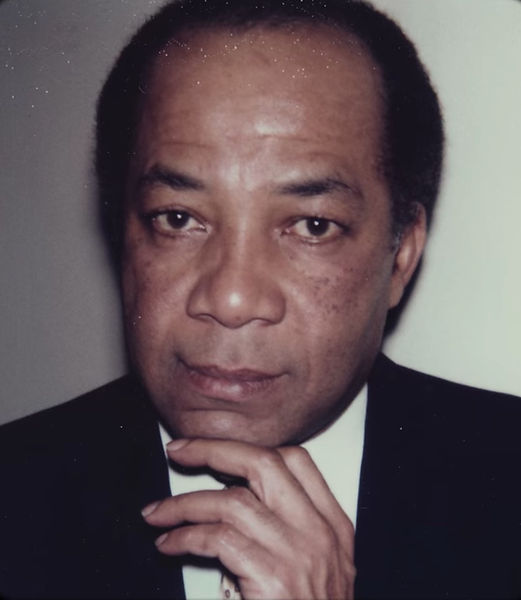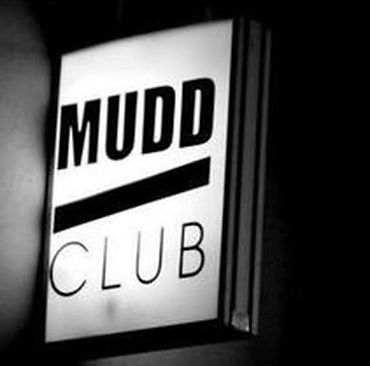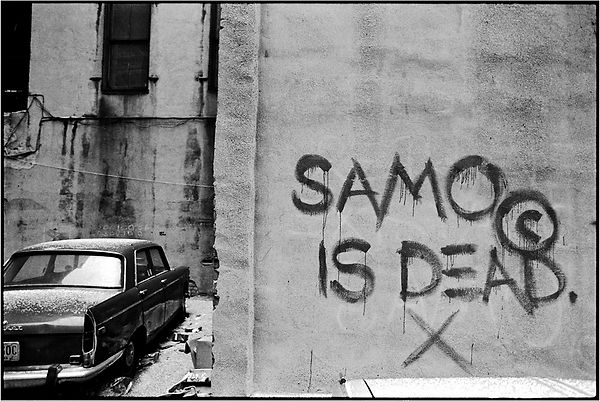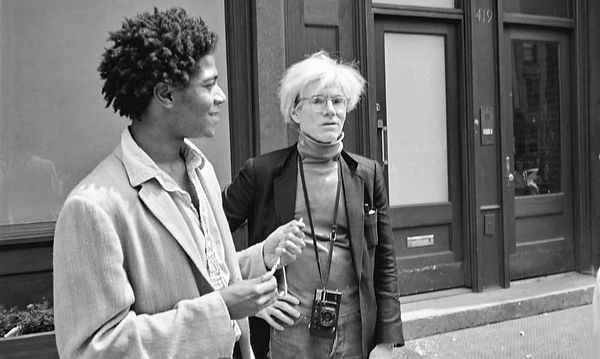
A Question so Effortlessly Petitioned,
but Seemingly Impossible to Completely
Answer... UNTIL NOW!
Basquiat
Who?

basquiat who?
Thats A question so Effortlessly Petitioned, but Seemingly Impossible to Completely Answer… Until Now. I like many of you over the last decade have Started Seeing everything from Clothes, Shoes, bags, housewares and of course paintings that sell for millions of dollars. I Began to become very curious as to just who Jean Michel Basquiat was and what makes him so important.
Can one truly know another person? It's virtually impossible to know someone unless you've lived his or her life. The many life experiences that help shape us -giving birth to the individual qualities that determine who we are and what we become-make it hard to even then know ourselves. In this attempt to explore, appreciate, and understand the complex artist Jean Michel Basquiat, we will simplify his life into this Composition of complex ideas.


Objective:
We hope that within this article you will have a better understanding of Jean-Michel Basquiat's life experiences, from childhood to adulthood. And we also Manifest that you will be inspired by his determination and perseverance in the face of adversity, enabling him to influence an entire generation of artists and our culture as a whole. Ultimately, believing after reading this article, you can answer the question in your own words "Basquiat Who?".
Basquiat: The Man
Personality
Standing 5’10” with boyish charm and a strong sense of his attractiveness, Basquiat was a natural ladies’ man, surrounded by admirers, including Madonna and his significant emotional connection with Jennifer Goode. Known for his social fearlessness, Basquiat would say what he felt, but if crossed, he could be difficult to deal with. He had a passion for attention but also enjoyed indulging in reclusiveness, always pursuing art and even drugs with the same intensity.
He existed between two worlds, trying to maintain his self-identity while navigating the art world, where Black artists had little control. With his distinctive style—defined
by his iconic locs, going barefoot even in expensive suits—Basquiat exuded a nonchalant attitude toward wealth. Many saw his disregard for money as a sign that he wasn’t confined by its influence.


.jpg)




Family & Childhood
Born in Brooklyn in 1960, Basquiat had a Puerto Rican mother and a Haitian father. Raised in a multilingual, middle-class household, he faced racism at prestigious, predominantly white schools. A scholarship to St. Ann’s gave him a firsthand look at privilege, shaping his views on ambition and inequality.





Relationship with His Mother & Art
Basquiat’s love for art was nurtured by his mother, who introduced him to museums and the cultural life of Brooklyn. However, her struggles with mental health and a turbulent marriage deeply affected him, especially after his parents’ divorce.



Conflict with His Father
Basquiat’s relationship with his father, Gerard, was fraught with tension. Gerard’s success clashed with Basquiat’s rebellious nature, culminating in a violent confrontation that led Basquiat to run away at 15. Though his father later acknowledged his genius, their bond remained strained.



Runaway Years & Early Struggles
After leaving home, Basquiat lived a transient life, panhandling and struggling with addiction. Despite his fears of becoming a bum, he refused to return home, determined to make it on his own.


School & Rebellion
Basquiat’s school years were marked by rebellion, skipping classes, and drug use. Yet, he remained drawn to the art scene, frequenting the School of Visual Arts and The Mudd Club, where he mingled with New York’s creative elite.

.jpg)
Matilde for the Win
Matilde’s influence on young Basquiat was profound. An artist herself, Matilde took pride in her style and passed this creativity to Jean-Michel. She would often sit and draw with him, encouraging his artistic talents and nurturing a deep bond over their shared love of art.


I'm a paragraph. Click here to add your own text and edit me. It's easy.
The Color of Gray
At eight years old, Basquiat was hit by a car while playing in the street. During his recovery, Matilde gave him Gray’s Anatomy, a book that would forever shape his artistic approach. The detailed anatomical drawings influenced his fascination with the human body, which is evident in his signature skeletal figures.

Basquiat’s Art: The Teen Years (1973-1981)
The Rise of SAMO©
In high school, Basquiat met Al Diaz, and together they birthed SAMO©, an underground graffiti project that commented on societal issues. SAMO© graffiti appeared on subways, bridges, and galleries throughout New York, with cryptic statements like “SAMO© is coming.” The boldness and rebellion of SAMO© gained attention from The Village Voice and other publications, solidifying Basquiat’s place in the art world.


SAMO© is Dead
As Basquiat’s ambition grew, his partnership with Diaz ended. He famously announced, “SAMO© is dead,” signaling the end of his graffiti days and the beginning of his career as a fine artist.


The Canal Zone Party and Breakthrough
In that same week, Basquiat attended the iconic Canal Zone Party, which aimed to bring graffiti artists into the mainstream art scene. Despite not being invited, he arrived early, confidently carving out a space for himself. He even created a piece of graffiti on-site, finally revealing that he was the mind behind SAMO©. This bold move further cemented his place in the art world, and his collaborations with artists like Fab 5 Freddy and Michael Holman helped bridge the gap between street and fine art.
Basquiat’s ability to network was unparalleled. He became a regular at The Mudd Club, a hub for the counterculture and new wave movements, where he met Diego Cortez, an art curator who took an immediate interest in Basquiat’s style. Cortez, impressed by his boldness and creativity, became a key figure in promoting Basquiat’s art.


The Times Square Show
In June 1980, Basquiat’s rising popularity led to an invitation to participate in the Times Square Show, a breakthrough exhibition hosted by the artist collective COLAB. The event took place in a former massage parlor in New York’s seedy Times Square district, bringing together an eclectic mix of artists from different genres. Basquiat’s work stood out, especially his provocative outside signboard with the phrase “FREE SEX” (later replaced with “TIMES SQUARE SHOW”).
Curator Jeffrey Deitch was particularly struck by Basquiat’s ability to blend street graffiti with abstract expressionism. In a glowing review for Art in America, Deitch compared Basquiat to the legendary Willem de Kooning, further validating his transition from street artist to fine artist.

Downtown 81: The Leap to Film
Basquiat’s fame was growing, and in the early 1980s, he starred in Downtown 81 (also known as New York Beat Film), a movie produced by Glenn O’Brien about New York’s punk scene. The film gave Basquiat a platform to showcase not only his acting but also his burgeoning visual art career. Basquiat made his first canvas paintings during the production and sold his first artwork to Debbie Harry for $200—a sign of things to come.
Although the film was plagued by production issues and a limited budget, it marked another pivotal moment in Basquiat’s rise, blending his creative passions for art, music, and film. Years later, Downtown 81 would become a cult classic, cementing Basquiat’s place as a key figure in the cultural renaissance of downtown New York.

Basquiat’s Art: The Adult Years (1981-1987)
Diego Cortez: New York/New Wave
Diego Cortez, a downtown curator, was instrumental in introducing Basquiat to the elite art world. His 1981 New York/New Wave exhibition at MoMA PS1 catapulted Basquiat from a street artist to an art world sensation. Jean sold several pieces, and soon enough, galleries were clamoring to showcase his work.

Annina Nosei: The Soho Studio
Annina Nosei played a key role in Basquiat’s early commercial success. She provided him with a studio in the basement of her gallery, where he created many iconic pieces. Although their relationship soured, with Basquiat resenting how quickly his works were sold, Nosei’s influence in positioning him for success cannot be understated.


Larry Gagosian: Hollywood Exposure
Hollywood art dealer Larry Gagosian gave Basquiat his first West Coast exhibition, showcasing him to a new audience. Basquiat created 25 new paintings for the show, further cementing his status as a global art star. The show was a sell-out success, even as the pressures of fame began to take their toll on him.




Bruno Bischofberger: European Success
Bruno Bischofberger became Basquiat’s longest-tenured dealer. He helped elevate Basquiat’s career to new heights, including securing his participation in the prestigious Documenta 7 exhibition in Germany. By this point, Basquiat was selling works for upwards of $20,000.


Warhol: The Creative Partnership
Basquiat’s relationship with Andy Warhol became one of the most important in his life. After an initial encounter at the WPA restaurant, where Basquiat sold Warhol a postcard, their paths crossed again at The Factory. Basquiat made a bold impression by painting a portrait of the two of them within hours of meeting, titled Dos Cabezas, sparking Warhol’s interest.
Warhol became a mentor to Basquiat, even suggesting that Basquiat move into a loft owned by Warhol to focus on his work. Their collaboration flourished, resulting in joint exhibitions and the iconic Everlast photograph, where they posed as boxers, symbolizing their creative sparring. However, their 1985 joint exhibition received harsh criticism, with Basquiat being labeled Warhol’s “mascot.” This deeply affected Basquiat, leading to a rift between the two. Warhol’s sudden death in 1987 was devastating for Basquiat, contributing to his spiraling drug addiction and further isolating him from the art world.








Ouattara Watts and Cultural Exploration
In 1988, Basquiat met artist Ouattara Watts in Paris, forming an immediate and deep connection over their shared love for French culture and art. Basquiat often spoke about transitioning away from painting to focus on writing and music, and their friendship opened the door to new creative possibilities. Their bond led them on a journey to New Orleans, where Basquiat explored his cultural roots as a Black man, reconnecting with his heritage and visiting the Mississippi River as a symbolic gesture of self-discovery.


Basquiat’s Final Days
In his final effort to overcome heroin addiction, Basquiat sought refuge on Hawaii’s remote Hana coastline. Immersing himself in the local culture, he found solace in music and fishing, managing to get clean briefly. Yet, he soon replaced drugs with alcohol, still battling inner demons.
In the months leading up to his death, Basquiat planned to meet his friend, artist Ouattara Watts, in Abidjan, where they were set to participate in a shamanic ritual to help cleanse his addiction. However, delays in returning to New York caused him to reschedule the trip. Tragically, upon his return to his loft, Basquiat relapsed. On August 12, 1988, at the age of 27, he died of a heroin overdose.
Following his death, the shamans in Abidjan honored him with a nighttime ritual of fire, mystical dancing, and prayers—paying tribute to his life, his art, and the battles he could not overcome.
Basquiat’s later works, showcased during his final exhibition at the Cable Building in April 1988, revealed a darker tone, reflecting his inner turmoil. Paintings like Riding with Death and Man Dies symbolized his grim personal struggles. Yet, despite declining health and isolation, Basquiat remained in demand, with his works still selling for around $25,000.
When he passed, Basquiat left behind 917 drawings, 171 paintings, and a vast array of personal items, from designer suits to unfinished canvases, showcasing his eclectic nature. His influence continues to resonate through art, music, and fashion, cementing his legacy as one of the most impactful artists of his generation.







Basquiat: The BQUEST
I firmly believe that a truly successful person is someone who inspires and influences others to seek their higher purpose in life. In line with this belief, Jean-Michel Basquiat’s impact continues to thrive, even after his passing, through creative individuals who breathe new life into his legacy.
Basquiat’s influence reaches far beyond the confines of the art world. It permeates music, fashion, and culture itself. For instance, his iconic painting Birds on Money adorned the cover of The Strokes’ 2020 album, and his name is dropped in rap lyrics by artists like Kanye West, Jamila Woods, and Jay-Z.
Through Jay-Z, Basquiat’s influence has found a new and powerful connection to modern culture. Jay-Z, feeling a personal kinship with Basquiat’s life experiences, adopted the artist’s distinctive hairstyle as a tribute. Both men, celebrated for their revolutionary work, navigated immense wealth while confronting racial biases. In Picasso Baby, Jay-Z boldly proclaims, “I’m the new Jean Michel,” reflecting the enduring relevance of Basquiat’s creative spirit.
However, Basquiat’s influence isn’t confined to high art alone. His work is found in retail spaces—on T-shirts, keychains, and figurines—showing how deeply his legacy has penetrated popular culture. The irony here is striking: Basquiat, who fought against capitalist and imperialist ideologies through his art, now finds his image embraced by a consumer-driven society. It raises the question of how he might feel seeing his work celebrated in this context.
Despite this commercialization, Basquiat remains one of the most important artists of our time. His paintings broke down barriers between elite art and street culture, and he was a trailblazer for Black artists in the 1980s. He created space for artists of color to express themselves without conforming to the traditional standards of beauty and success imposed by society. Basquiat’s work challenged these norms, pushing people to define their own identities and paths.
His influence continues to shape art and culture, making him as relevant today as ever. Jean-Michel Basquiat’s legacy is not just about the work he left behind, but the inspiration he continues to ignite in people to seek their higher purpose and break through boundaries.





Conclusion: Ending Soliloquy
Basquiat’s life was a tapestry of contradictions—he was a rebel, a visionary, and a pioneer. His art was raw, unfiltered, and layered with meaning. It dared to challenge societal norms, provoke thought, and evoke emotion. Through his work, Basquiat captured the complexities of identity, race, and the human condition. Even in death, his influence continues to reverberate, not only in the art world but across culture as a whole.
Basquiat’s genius lay in his ability to combine simplicity with depth. He brought the struggles of being Black in America to the forefront, making them visible and undeniable through his art. His legacy is one of defiance, creativity, and a relentless pursuit of truth. He taught us that art should not be confined by rules, and that true expression lies in the willingness to challenge, to push boundaries, and to embrace the chaotic beauty of life.
Jean-Michel Basquiat’s art reminds us to see the world not just as it is, but as it could be—bold, messy, and full of possibilities.

















_PNG.png)